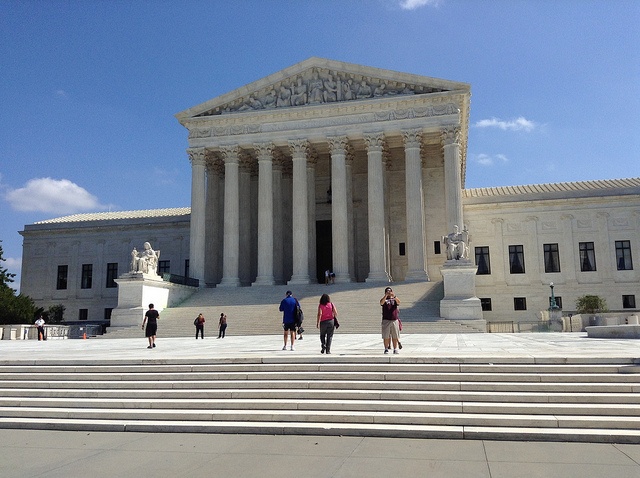Supreme Court affirms 'one person, one vote' in Texas case but leaves opening for states to change that

The U.S. Supreme Court ruled this week that Texas state legislative maps drawn based on total population were valid, but it did not take a stance on whether states could choose to draw them based on voter population instead. (Photo by Jonathan Satriale via Flickr.)
This week, the Supreme Court ruled in favor of Texas in a voting rights case with major implications for legislative representation and the balance of political power in Southern states.
At question was the longstanding principle of "one person, one vote," which stipulates that total population — including those ineligible to vote such as children, non-citizens and disenfranchised ex-felons — is considered for representation and redistricting purposes. Congressional districts are constitutionally required to use this standard, and every state in the country has also used it for years to apportion state and local districts.
That principle was challenged in the recent Supreme Court case of Evenwel v. Abbott by two Texas voters represented by the Project on Fair Representation. The conservative legal advocacy firm also brought the Shelby County v. Holder case in which the Supreme Court struck down key parts of the Voting Rights Act in 2013.
The plaintiffs argued that counting the entire population for the purposes of drawing district lines diluted the power of citizens in districts with smaller numbers of non-voting residents. Legislative maps, they argued, should equalize the number of eligible voters rather than the whole population.
But on Monday, the Supreme Court ruled unanimously that Texas' Senate maps were valid, affirming a lower court's decision.
"We hold, based on constitutional history, this Court's decisions, and longstanding practice, that a State may draw its legislative districts based on total population," Justice Ruth Bader Ginsburg wrote in the court's majority opinion.
The decision was widely viewed as a win against what one Vox headline referred to as the "demographic equivalent of gerrymandering." That's because under a voter-based district plan, political power in states was was likely to shift from places with younger, more racially diverse, urban and often Democratic districts to older, whiter, rural and largely Republican ones, as studies have found.
The potential impact in the South was great, given the rapid growth of the region's Latino and Asian-American communities where many are ineligible to vote. Districts with large immigrant populations in Texas and Florida would have been most affected, as well as urban centers in places like Georgia and North Carolina.
"This is a clear and important victory for the use of total population in redistricting," said Nina Perales from the Mexican American Legal Defense and Education Fund, which filed an amicus brief on behalf of the Texas Senate Hispanic Caucus and the Texas House Mexican American Legislative Caucus defending the state's approach to drawing districts.
"The decision protects the right of all people across the U.S. to be represented by their officials and be counted when electoral maps are drawn."
Door remains open for states to count only voters
But the court did not rule on another critical issue the case raised, leaving open the question of whether states have the right to choose for themselves whether to draw districts based on total population or eligible voter population.
The states' rights argument was made by the attorneys representing Texas in the case and raised concerns among voting rights advocates that states may adopt their own voter population-based district plans. Texas' arguments veered from that of federal lawyers also involved in the case who argued that all districts should be drawn based on total population.
Some observers thought the court's non-decision on the matter was good news for voting rights advocates. They included University of California Irvine law professor Rick Hasen, who wrote on his Election Law Blog:
Perhaps the most important aspect of Justice Ginsburg's opinion, and especially notable because it attracted the votes of not just the liberals but also Chief Justice Roberts and Justice Kennedy, is the Court's refusal to give Texas the green light to use total voters if it wants in the next round of redistricting. The Court simply put the issue off for another day. It is hard to stress enough what a victory this is for liberal supporters of voting rights. ... The fact that the Court leaves that issue open will serve as a deterrent for states like Texas to try to use total voters in the next round of redistricting, because it will guarantee major litigation on the question.
But others are skeptical — especially given that many states have been enacting restrictive election laws that target the same demographic groups disadvantaged by voter-based district plans.
"While the justices refused to order states to count only voters when drawing districts, they stopped short of saying states couldn't do that, in effect saying the court could decide the issue if and when another case came up to pose it," the editorial board at USA Today wrote.
"That seems likely: The door is now wide open for Republican legislators to change redistricting policy to include only voters."
Tags
Allie Yee
Allie is a research fellow at the Institute for Southern Studies and is currently studying at the Yale School of Management. Her research focuses on demographic change, immigration, voting and civic engagement.
